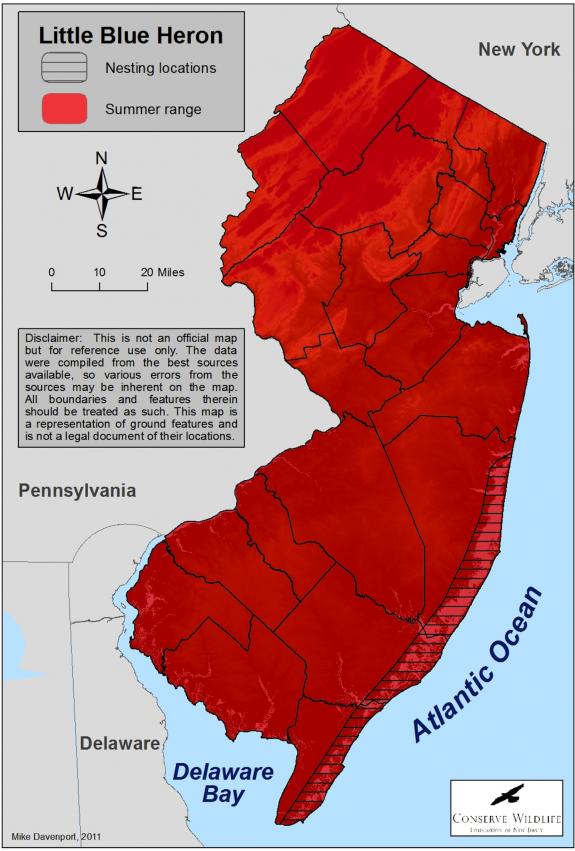Egretta caerulea
Type: bird
Status: special concern
Species Guide
Little blue heron
Egretta caerulea
Species Type: bird
Conservation Status: special concern
IDENTIFICATION
The little blue heron is a medium-sized heron with a dark slate blue body and a purple head and neck. It has a slender build, long neck, long dark legs, and a dark bill. Males and females look similar. They grow to a length of 24 inches with a wingspan of 40 inches.
During the non-breeding season, this heron’s lores are a dull green. In the breeding season, the adult’s lores and the base of the bill become turquoise and long plumes will develop on the bird’s crest and back.
This species is unique amongst the herons and egrets in that, whereas the adult’s coloration is dark, the juvenile is white. The juvenile’s wing however, may be tipped with some gray.

Distribution & Habitat
The little blue heron breeds as far north as southeastern Canada and the Midwest US. They are a year-round resident in the southeastern US, West Indies, Mexico, and as far south as northern South America.
This is primarily a coastal species in New Jersey. They will breed near fresh, brackish, or salt water. Nesting locations within New Jersey have only been documented along the shorelines of Barnegat Bay and south. However, they will forage in water bodies and marsh outside of the coastal area.
Little blue herons’ preferred habitat is wetland and forest bordering water bodies. They nest in trees or shrubs by fresh or salt water and forage in and alongside water bodies. Nests are usually between 8-15 feet above the ground.
Diet
Little blue herons feed on aquatic invertebrates and fish. They feed by standing or walking slowly in or alongside water, with their neck bent forward at a 45-degree angle. When they see prey, they then spear it with their sharp bill.
Life Cycle
The little blue heron’s breeding season begins in April and usually ends by late August or mid-September. They nest in colonies which are often quite large and may be occupied by other heron and egret species as well.
The female builds the nest while the male delivers nesting material to her. Three to five pale greenish-blue eggs are laid and then incubated by both adults for 22-24 days. The nestlings are semi-altrical and are cared for by both adults. The young can leave the nest by 12 days old and can make short flights by the age of 30 days. They become independent of their parents by 35-49 days old.
Current Threats, Status, and Conservation
Currently, the greatest threat to the little blue heron is habitat loss and degradation together with disturbance of nesting colonies. Wetland destruction has caused a decrease in heron populations from their historic numbers. Since the 1950’s, habitat loss has occurred at an alarming rate in New Jersey, destroying wetlands critical to breeding herons. This species is listed as Special Concern during the breeding and non-breeding seasons.
Like many species in New Jersey, protecting little blue herons is closely tied with protecting their wetland habitats. Strong environmental laws to protect wetlands from disturbance and development help to protect wetlands and the heron.
We still have much to learn about the biology and population status of little blue herons in New Jersey. Research needs to be completed to find additional breeding sites, check existing nesting areas, and determine whether the population might be decreasing or increasing.
References
Text written by Michael J. Davenport in 2011.
Scientific Classification
- Kingdom: Animalia
- Phylum: Chordata
- Class: Aves
- Order: Ciconiformes
- Family: Ardeidae
- Genus: Egretta
- Species: E. caerulea